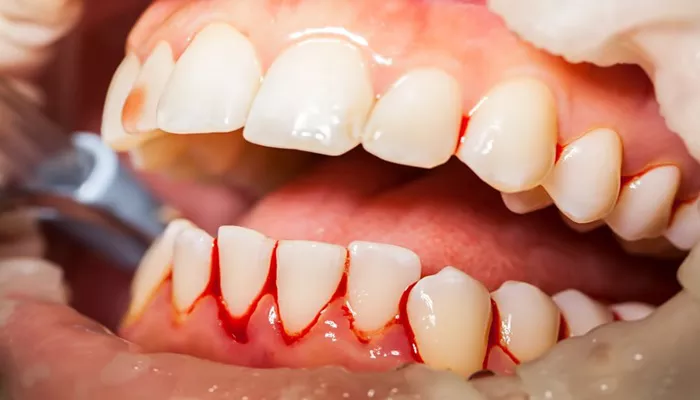Wisdom teeth, also known as third molars, often require removal due to impaction, misalignment, or risk of infection. One common concern after a wisdom tooth extraction is bleeding. Patients frequently ask: How long should wisdom teeth bleed? This article provides a thorough explanation of post-extraction bleeding, its causes, and its implications, including how it may relate to gum inflammation and gum disease.
Initial Bleeding After Wisdom Tooth Extraction
What Is Normal Bleeding?
Bleeding is a natural response following the removal of a wisdom tooth. In most cases, bleeding lasts for up to 24 hours. Slight oozing or a blood-tinged saliva is common during this period. The formation of a blood clot is an essential step in the healing process.
Factors That Affect Bleeding Duration
Several factors can influence how long bleeding lasts:
- The complexity of the extraction
- Patient’s age and overall health
- Use of blood thinners or other medications
- Patient’s adherence to post-operative instructions
How to Control Bleeding After Wisdom Tooth Extraction
Immediate Measures to Stop Bleeding
To control bleeding, dentists recommend the following steps immediately after surgery:
- Bite firmly on a gauze pad for 30-45 minutes
- Replace gauze as directed
- Avoid spitting, sucking, or rinsing forcefully
- Keep the head elevated
Home Remedies to Support Clotting
Home remedies can assist in clot formation:
- Moist tea bags placed over the site—tannic acid promotes clotting
- Cold compresses to reduce swelling and vessel dilation
These methods are helpful in preventing excessive gum inflammation and aiding the clotting process.
When Does Bleeding Become a Concern?
Signs of Abnormal Bleeding
Bleeding that persists beyond 24 hours or returns after stopping can indicate a complication. Signs that require immediate dental attention include:
- Heavy bleeding that soaks through multiple gauze pads
- Formation of large clots
- Continuous bleeding beyond 48 hours
Underlying Conditions
Certain conditions can prolong bleeding:
- Blood clotting disorders
- Diabetes or autoimmune diseases
- Use of anticoagulant medications
These conditions should be discussed with your dentist before surgery to manage risks effectively.
Dry Socket: A Common Post-Extraction Complication
What Is a Dry Socket?
A dry socket occurs when the blood clot is dislodged or dissolves prematurely. This exposes the underlying bone and nerves, causing intense pain and delayed healing. Dry socket may be accompanied by gum inflammation and a foul odor.
Preventing Dry Socket
To avoid this condition, patients should:
- Avoid using straws or smoking for at least 72 hours
- Follow a soft-food diet
- Maintain gentle oral hygiene
Bleeding and Gum Inflammation
How Bleeding Affects the Gums
Prolonged bleeding can irritate the gum tissue, leading to gum inflammation. Inflamed gums may become red, swollen, and tender. This can delay healing and contribute to the development of other oral health issues.
Relation to Gum Disease
Chronic inflammation post-extraction can contribute to gum disease. This may manifest as:
- Persistent bleeding gums
- Loose teeth
- Gum recession
- Bad breath or taste
Timely management of bleeding and inflammation can prevent these complications.
Proper Oral Hygiene After Extraction
Cleaning the Mouth Safely
Good hygiene is essential for healing:
- Brush gently around the extraction site
- Use saltwater rinses after 24 hours
- Avoid commercial mouthwashes that may irritate the tissue
Preventing Infection
Infections can prolong bleeding and damage the surrounding gums. Symptoms of infection include:
- Swelling
- Fever
- Pus discharge
See a dentist promptly if these symptoms arise to avoid progression to gum disease.
Diet and Lifestyle Tips to Reduce Bleeding
Foods That Promote Healing
Soft, nutrient-rich foods support recovery:
- Yogurt
- Mashed potatoes
- Soup (cooled)
- Scrambled eggs
Habits to Avoid
To minimize bleeding:
- Do not smoke
- Avoid strenuous physical activity for 48 hours
- Do not drink alcohol or caffeine during recovery
Role of Medications in Bleeding Control
Prescription Medications
After extraction, your dentist may prescribe:
- Antibiotics to prevent infection
- Anti-inflammatories for pain and swelling
Over-the-Counter Medications
Non-aspirin pain relievers are preferred as aspirin can thin the blood and extend bleeding. Always follow the instructions provided by your healthcare provider.
When to Contact Your Dentist
Red Flags to Watch For
Contact your dentist if you experience:
- Excessive bleeding beyond 24–48 hours
- Signs of infection
- Swelling that worsens instead of improves
Importance of Follow-Up Visits
Post-operative appointments allow your dentist to monitor healing and intervene early if complications arise. These visits are vital to preventing gum disease and other chronic oral health issues.
Healing Timeline After Wisdom Tooth Removal
What to Expect During Recovery
The healing process generally follows this timeline:
- First 24 hours: Clot formation and initial healing
- Days 2–3: Swelling and mild bleeding may persist
- Days 4–7: Bleeding should stop, and soft tissue begins to regenerate
- Week 2 onwards: Major healing occurs with decreasing discomfort
Complete Healing
While the soft tissues heal within a few weeks, full bone healing may take 2–3 months. Adhering to care guidelines ensures proper recovery and reduces the risk of complications such as gum inflammation.
Conclusion
Bleeding after wisdom tooth extraction is normal and usually lasts up to 24 hours. Minor oozing may occur for another day or two. Persistent or excessive bleeding may indicate complications like dry socket or infection, especially if accompanied by gum inflammation.
Maintaining oral hygiene, following post-operative instructions, and attending follow-up appointments are critical steps in preventing gum disease and ensuring complete recovery. If in doubt, always consult your dental professional for guidance and reassurance.

